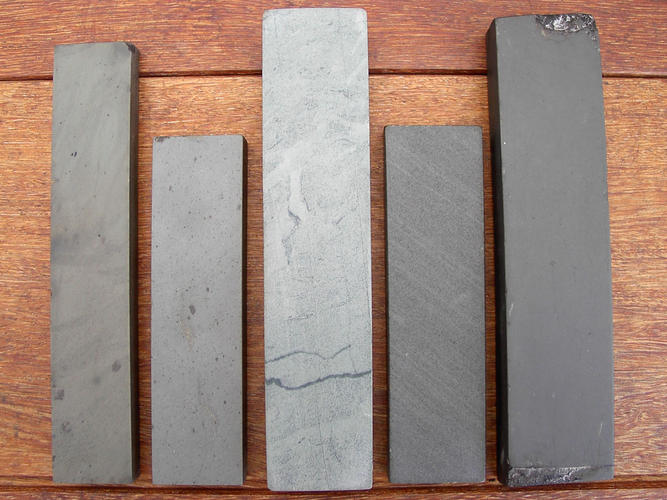Results 11 to 20 of 27
Thread: Natural stone identification!!
-
01-14-2012, 03:06 PM #11
-
01-14-2012, 03:18 PM #12Historically Inquisitive



- Join Date
- Aug 2011
- Location
- Upstate New York
- Posts
- 5,782
- Blog Entries
- 1
Thanked: 4249
[QUOTE=Piet;906310]Actually this type of LI is usually very uniform in color with a very subtle speckle pattern which you probably won't see until it's lapped and you're looking upclose.
These are probably all LIs, the one at the right is a similar type as Martin's LI.
I totally agree Piet, the one on the right look just like mine.Since im not quite done lapping where does this stone fall into the progression?
And since you have 5 of them are they all different ?
-
01-14-2012, 03:33 PM #13

The two at the left are of the same type, they just look a little different. The two at the right are very similar but because I have and have seen more of both I'd say they are a different type. Both types are extremely hard, they have tiny flaking in chips and a similar shade of green.
Last edited by Piet; 01-14-2012 at 03:57 PM.
-
01-14-2012, 03:47 PM #14Senior Member

- Join Date
- Mar 2009
- Posts
- 1,211
Thanked: 202
I would also agree with LI. And also feel sorry for the soul who wants to lap it flat with minimum of nicks in the surface. it will be a big job. Be carefull with lapping do it slow with a lot of water or even running otherwise they tehd to overheat and flake as they expand. So far I did not have problem honing with these flakes but it certainly look nicer without.
-
01-14-2012, 03:48 PM #15

wow great thread guys this was a good learning experience for me i didnt know that LI had two different appearance's
-
01-14-2012, 04:18 PM #16Historically Inquisitive



- Join Date
- Aug 2011
- Location
- Upstate New York
- Posts
- 5,782
- Blog Entries
- 1
Thanked: 4249
-
01-14-2012, 05:34 PM #17Senior Member



- Join Date
- Apr 2008
- Location
- Essex, UK
- Posts
- 3,816
Thanked: 3164
Lapidary grit in various grit sizes (eg 100, 180, 240, 320 - you can go up to 600 but for some reason 600 and above a bit harder to get hold of), water, flat hard surface (cast iron plate/thick glass/granite) and a lot of rubbing. Quicker than a diamond plate and you can make longer/wider sweeps. Just put a small mound of grit on the plate, pour on some water and go at it. Makes a lot of mess, though. You can always true-up with the diamond plate if you suspect that your surface wasn't flat enough or you have allowed a build-up under the hone that has resulted in a slight roll of the surface. Usually not necessary though if you are careful.
Regards,
Neil
-
01-14-2012, 06:38 PM #18Historically Inquisitive



- Join Date
- Aug 2011
- Location
- Upstate New York
- Posts
- 5,782
- Blog Entries
- 1
Thanked: 4249
-
01-14-2012, 06:50 PM #19Senior Member

- Join Date
- Mar 2009
- Posts
- 1,211
Thanked: 202
Same as with CFs decent finisher.
-
01-14-2012, 06:57 PM #20Senior Member



- Join Date
- Apr 2008
- Location
- Essex, UK
- Posts
- 3,816
Thanked: 3164
Yes, very decent finisher.
Regards,
Neil


 LinkBack URL
LinkBack URL About LinkBacks
About LinkBacks








 Reply With Quote
Reply With Quote